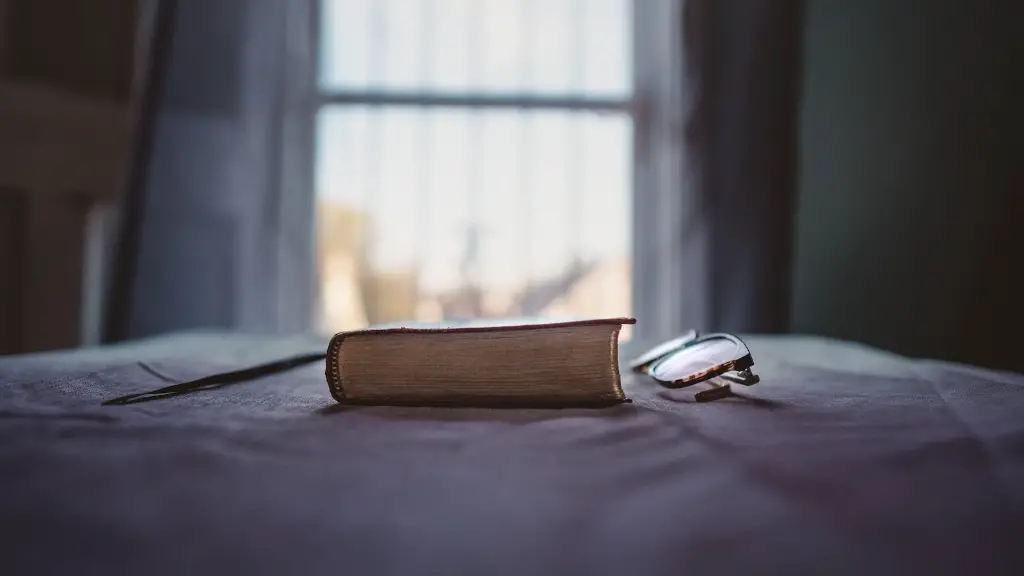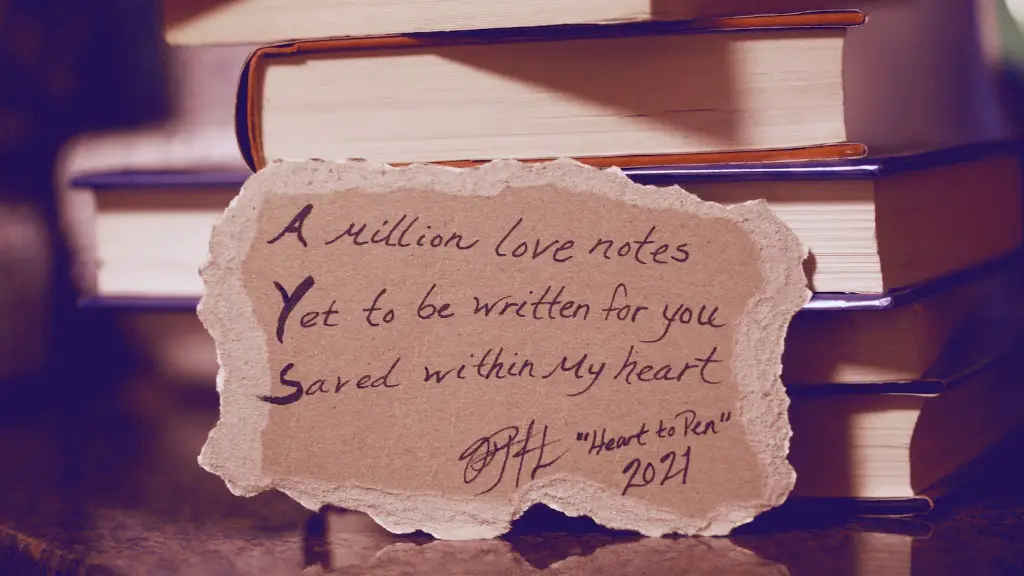Quoting Poetry in APA- How to Cite Poetry Correctly
When quoting poetry in any form of written work, it is important to make sure that the source is accurately identified and given attributions. For academic writing, this is particularly important when quoting poetry, as there is a specific way to cite it in the APA format- the style commonly used in academic writing that is based on the most current version of the Publication Manual of the American Psychological Association.
When citing a poem, the name of the poem, its author, and page numbers should be included in the text of the document, as well as the year of publication. The full reference should appear in the reference list at the end of the document.
When quoting from a poem, be sure to cite the section of the poem that is being quoted. For example, for a poem that appeared in a print edition, the page numbers need to be included in the in-text citation, as follows: (“The Song of Hiawatha,” 2020, p. 10). If you are citing a poem that was published online, include the website address, as well as the publication date, in the in-text citation. For example: (“The Song of Hiawatha,” 2020, http://example.com).
When quoting poetry that is written in stanzas, it is important to make sure that you are quoting the exact same stanza throughout your paper. If you quote from a different stanza, it could be seen as a different source of the same poem. The exact stanza should be cited in the in-text citation. For example, (“The Song of Hiawatha,” 2020, p. 10, stanza 1).
When quoting from a poem, it is important to correctly format the quote in your paper. The specific guidelines for quoting poetry can be found in the APA style manual. Generally, when quoting from a poem, the lines should be presented in the same format as they appear in the original poem. That is, the text should be presented in the same font and size and should be separated by the same indentation and line breaks as the original poem. Additionally, all punctuation marks that appear in the poem should be included in the quoted portion.
When quoting poetry, it is important to make sure that the quote accurately presents the words of the original author. Quotes used must be precise, without any changes to the original words or punctuation. Any changes that are made must be indicated with brackets, such as [square brackets].
Quote Marks in Poetry Quotes
When quoting poetry, it is important to make sure that you present the words of the original author exactly as they appear. This means that all quote marks should be retained, as well as any other punctuation. Furthermore, it is important to make sure that the quote is enclosed in two sets of quotation marks: the first set of quotation marks marks the beginning of the quote, and the second set of quotation marks marks the end of the quote.
For example, when quoting from a poem titled, “The Song of Hiawatha”, one shouldinclude the quote marks around the sections being quoted, as follows:
“By the shores of Gitche Gumee,
By the shining Big-Sea-Water,
Stood the wigwam of Nokomis,
Daughter of the moon, Nokomis.”
(“The Song of Hiawatha”, 2020, p. 10)
It is also important to note that when quoting poetry in the APA format, all words that are not part of the original quote should be enclosed in brackets, such as [square brackets]. This is to indicate to the reader that the words have been added to the quote.
Quoting More Than Four Lines of Poetry
When quoting more than four lines of poetry, the APA style requires the lines to be single-spaced and indented five spaces. Additionally, the quote should be followed by a citation, as per the format laid out above.
The lines should be presented exactly as they appear in the original poem, and no changes should be made to the words or punctuation. It is also important to note that the quote must be enclosed within double quotation marks.
For example:
“By the shores of Gitche Gumee,
By the shining Big-Sea-Water,
Stood the wigwam of Nokomis,
Daughter of the moon, Nokomis.”
(“The Song of Hiawatha”, 2020, p. 10)
Quoting Lines From Different Stanzas of a Poem
It is possible to quote from different stanzas of a poem in the same paper. However, it is important to note that each stanza that is quoted needs to be cited separately. That is, a separate in-text citation should be used for each stanza that is quoted. Additionally, the line numbers of the stanza must be indicated in the in-text citation.
For example, when quoting from the poem “The Song of Hiawatha”, a separate in-text citation should be used for each stanza that is quoted. For example:
(“The Song of Hiawatha”, 2020, p. 10, stanza 1) and (“The Song of Hiawatha”, 2020, p. 10, stanza 2).
Quoting Quotations Within Quotes
When quoting multiple authors, it is important to make sure that quote marks are used for any words that are quoted within the quote. That is, when quoting another author’s words within the quotation, the words should be enclosed in double quotation marks. For example:
“In her poem “The Song of Hiawatha,” Longfellow writes: “By the shores of Gitche Gumee…””
(“The Song of Hiawatha”, 2020, p. 10)
Difficult Words in Poetry
When citing a poem that includes difficult to read words, it is important to make sure that the words are correctly formatted in the paper. It is also important to make sure that the words are accurately transcribed. For example, if the poem contains dialect or words used in a foreign language, the original words should be retained and any special characters that appear should be indicated with a bracketed note. For example:
“By the shores of Gitche Gumee,
By the shining Big-Sea-Water,
Stood the wigwam of Nokomis,
Daughter of the moon, [in Ojibwe language, “Nokomis”].”
(“The Song of Hiawatha”, 2020, p. 10)
Line and Stanza Long Quotes
When quoting long sections of poetry, it is important to make sure that all the lines are included and that the quote is the same length as the original poem. Additionally, the quote should be presented in the same format as the original poem, with indentation and line breaks. The quote should also be followed by a citation.
For example:
“By the shores of Gitche Gumee,
By the shining Big-Sea-Water,
Stood the wigwam of Nokomis,
Daughter of the moon, Nokomis.
Dark behind it rose the forest,
Rose the black and gloomy pine-trees,
Rose the firs with cones upon them;
Bright before it beat the water,
Beat the clear and sunny water,
Beat the shining Big-Sea-Water.”
(“The Song of Hiawatha”, 2020, p. 10)
Quoting Poetry with Non-Standard Text
When quoting from a poem that features non-standard text or formatting, such as italics or bold font, it is important to make sure that these features are also included in the quoted portion. For example, if the poem is written in italics, the quoted portion should also be written in italics.
For example:
“By the shores of Gitche Gumee,
By the shining Big-Sea-Water,
Stood the wigwam of Nokomis,
Daughter of the moon, Nokomis.”
(“The Song of Hiawatha”, 2020, p. 10)
Quoting Partial Lines
When quoting partial lines from a poem, it is important to make sure that the quote accurately reflects the words of the original authors. That is, all punctuation should be included, and any changes should be indicated with a bracketed note. Additionally, the quote should be enclosed in double quotation marks.
For example, when quoting partial lines from the poem “The Song of Hiawatha”, the quote should be formatted as follows:
“By the shining Big-Sea- Water,
Stood the wigwam of Nokomis,
Daughter of the moon, [in Ojibwe language, “Nokomis”].”
(“The Song of Hiawatha”, 2020, p. 10)
Quoting Translations
When quoting a translated poem, it is important to make sure that the quote reflects the words of the translator. Additionally, the in-text citation should include the name of the translator, as well as the year of publication of the translation.
For example:
“By the shores of Gitche Gumee,
By the shining Big-Sea- Water,
Stood the wigwam of Nokomis,
Daughter of the moon, Nokomis.”
(“The Song of Hiawatha”, translated by John Smith, 2020, p. 10)
Multiple Authors
When quoting poetry written by multiple authors, it is important to make sure that the original authors are accurately identified and given attributions. The in-text citation should list all the authors, separated by the word “and”. For example:
“By the shores of Gitche Gumee,
By the shining Big-Sea-Water,
Stood the wigwam of Nokomis,
Daughter of the moon, Nokomis.”
(“The Song of Hiawatha”, by Henry Wadsworth Longfellow and John Smith, 2020, p. 10)
Quoting Poetry with Annotated Sources
When citing an annotated version of a poem, it is important to make sure that the original source is accurately identified, as well as any other sources that are used for annotation. The in-text citation should include the original author of the poem, as well as any annotators or translators. For example,
“By the shores of Gitche Gumee,
By the shining Big-Sea- Water,
Stood the wigwam of Nokomis,
Daughter of the moon, Nokomis.”
(“The Song of Hiawatha”, by Henry Wadsworth Longfellow, annotated by John Smith, 2020, p. 10)
Conclusion
It is important to make sure that when quoting poetry, the source is accurately identified and that words are presented in the same format as they appear in the original poem. Additionally, all punctuation should be included and any changes made to the original words should be indicated with a bracketed note. Finally, it is important to make sure that the quoted text is enclosed within two sets of double quotation marks.



